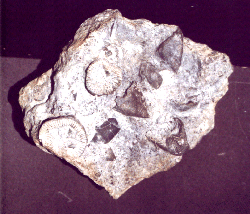Brachiopods
Age: Silurian
Formation: Thornloe
 Phylum Brachiopoda range from the Lower Cambrian to Recent. They have been called the most diverse, abundant and conspicuous fossil animals in the Paleozoic Era. All species are marine, and many inhabited deep, cold water. They spent their lives either stuck to a fleshy stalk that was attached to a firm substrate, lying free on the sea floor, or adhered to objects via spines. All brachiopods have 2 valves, and resemble the Bivalvia, but the orientation of their soft parts separates these two groups. The two valves are ALWAYS unequal. When closed, the shell looks egg-shaped, but they may also be flat or spherical. Most specimens show some kind of sculpturing, most commonly seen in the forms of radial ribs. These ribs run the range of very fine to coarse in nature. The shell is composed of either a mixture of chitin and calcium phosphate with small amounts of other minerals, or of calcium carbonate with small amounts of organic material.
Phylum Brachiopoda range from the Lower Cambrian to Recent. They have been called the most diverse, abundant and conspicuous fossil animals in the Paleozoic Era. All species are marine, and many inhabited deep, cold water. They spent their lives either stuck to a fleshy stalk that was attached to a firm substrate, lying free on the sea floor, or adhered to objects via spines. All brachiopods have 2 valves, and resemble the Bivalvia, but the orientation of their soft parts separates these two groups. The two valves are ALWAYS unequal. When closed, the shell looks egg-shaped, but they may also be flat or spherical. Most specimens show some kind of sculpturing, most commonly seen in the forms of radial ribs. These ribs run the range of very fine to coarse in nature. The shell is composed of either a mixture of chitin and calcium phosphate with small amounts of other minerals, or of calcium carbonate with small amounts of organic material.
 Advance One Slide
Advance One Slide
 Go Back One Slide
Go Back One Slide